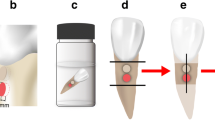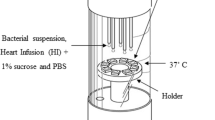Abstract
Objectives
The objective of this study was to investigate the effect of different glass ionomer cements on secondary caries inhibition in a fully automated in vitro biofilm model.
Materials and methods
One hundred and twenty-four extracted third molars received class V cavities and were filled with one conventional (Ketac Molar/KM), and two resin-modified glass ionomer cements (Photac Fil/PF, Ketac N100/KN, 3M Espe). A bonded resin composite (Single Bond Plus/Filtek Supreme XTE) served as control. After 14 days water storage at 37 °C, specimens were thermocycled (10,000 × 5/55 °C). Over a period of 10 days, specimens were subjected to cariogenic challenge for 3/4/6 h/day. Demineralization was caused by Streptococcus mutans (DSM 20523) alternatingly being rinsed over specimens using artificial saliva. After biological loading, teeth were cut longitudinally and demineralization depths were evaluated at the margins and at a distance of 0.5 mm from the margins using fluorescence microscopy. Marginal quality was investigated under a SEM at ×200 magnification.
Results
Four-hour demineralization depths were for enamel margins (EM), enamel (E), dentin margin (DM), and dentin (D) (μm ± SD): KM: EM 12 ± 8, E 33 ± 7, DM 56 ± 11, D 79 ± 6; PF: EM 19 ± 13, E 34 ± 13, DM 53 ± 10, D 77 ± 12; and KN: EM 26 ± 5, E 38 ± 6, DM 57 ± 11, D 71 ± 7. For all glass ionomer cements (GICs), demineralization depth at the margins was less compared to 0.5 mm distance, with demineralization depth having been correlated to duration of cariogenic challenge (ANOVA [mod. LSD, p < 0.05]). Compared to the bonded resin composite, all GICs exhibited caries inhibition at restoration margins in enamel and dentin.
Conclusions
Fluoride-releasing GIC materials exhibit a secondary caries inhibiting effect in vitro.
Clinical relevance
Glass ionomer cements have a higher secondary caries inhibiting effect than resin composites.










Similar content being viewed by others
References
Frankenberger R, Reinelt C, Kramer N (2014) Nanohybrid vs. fine hybrid composite in extended class II cavities: 8-year results. Clin Oral Investig 18:125–137
Hickel R, Manhart J, Garcia-Godoy F (2000) Clinical results and new developments of direct posterior restorations. Am J Dent 13:41D–54D
Manhart J, Chen H, Hamm G, Hickel R (2004) Buonocore Memorial Lecture. Review of the clinical survival of direct and indirect restorations in posterior teeth of the permanent dentition. Oper Dent 29:481–508
Opdam NJ, van de Sande FH, Bronkhorst E, Cenci MS, Bottenberg P, Pallesen U, Gaengler P, Lindberg A, Huysmans MC, van Dijken JW (2014) Longevity of posterior composite restorations: a systematic review and meta-analysis. J Dent Res 93:943–949
Barata JS, Casagrande L, Pitoni CM, de Araujo FB, Garcia-Godoy F, Groismann S (2012) Influence of gaps in adhesive restorations in the development of secondary caries lesions: an in situ evaluation. Am J Dent 25:244–248
Da Rosa Rodolpho PA, Donassollo TA, Cenci MS et al (2011) 22-year clinical evaluation of the performance of two posterior composites with different filler characteristics. Dent Mater 27:955–963
Frankenberger R, Kramer N, Lohbauer U, Nikolaenko SA, Reich SM (2007) Marginal integrity: is the clinical performance of bonded restorations predictable in vitro? J Adhes Dent 9(Suppl 1):107–116
Van Meerbeek B, De Munck J, Yoshida Y, Inoue S, Vargas M, Vijay P, Van Landuyt K, Lambrechts P, Vanherle G (2003) Buonocore memorial lecture. Adhesion to enamel and dentin: current status and future challenges. Oper Dent 28:215–235
Cenci MS, Pereira-Cenci T, Cury JA, Ten Cate JM (2009) Relationship between gap size and dentine secondary caries formation assessed in a microcosm biofilm model. Caries Res 43:97–102
Demarco FF, Correa MB, Cenci MS, Moraes RR, Opdam NJ (2012) Longevity of posterior composite restorations: not only a matter of materials. Dent Mater 28:87–101
Dennison JB, Sarrett DC (2012) Prediction and diagnosis of clinical outcomes affecting restoration margins. J Oral Rehabil 39:301–318
Krämer N, Kunzelmann KH, Garcia-Godoy F, Haberlein I, Meier B, Frankenberger R (2007) Determination of caries risk at resin composite margins. Am J Dent 20:59–64
Frankenberger R, Reinelt C, Petschelt A, Krämer N (2009) Operator vs. material influence on clinical outcome of bonded ceramic inlays. Dent Mater 25:960–968
Peumans M, Kanumilli P, De Munck J, Van Landuyt K, Lambrechts P, Van Meerbeek B (2005) Clinical effectiveness of contemporary adhesives: a systematic review of current clinical trials. Dent Mater 21:864–881
van de Sande FH, Opdam NJ, Truin GJ, Bronkhorst EM, de Soet JJ, Cenci MS, Huysmans MC (2014) The influence of different restorative materials on secondary caries development in situ. J Dent 42:1171–1177
van Dijken JW, Pallesen U (2014) A randomized 10-year prospective follow-up of class II nanohybrid and conventional hybrid resin composite restorations. J Adhes Dent 16:585–592
van Dijken JW, Pallesen U (2015) Randomized 3-year clinical evaluation of class I and II posterior resin restorations placed with a bulk-fill resin composite and a one-step self-etching adhesive. J Adhes Dent 17:81–88
Frankenberger R, Krämer N, Petschelt A (2000) Technique sensitivity of dentin bonding: effect of application mistakes on bond strength and marginal adaptation. Oper Dent 25:324–330
Hickel R, Manhart J, Garcia-Godoy F (2000) Clinical results and new developments of direct posterior restorations. Am J Dent 13:41D–54D
Kidd EA, Beighton D (1996) Prediction of secondary caries around tooth-colored restorations: a clinical and microbiological study. J Dent Res 75:1942–1946
Krämer N, Möhwald M, Lücker S, Domann E, Zorzin JI, Rosentritt M, Frankenberger R (2015) Effect of microparticulate silver addition in dental adhesives on secondary caries in vitro. Clin Oral Investig 19:1673–1681
Paradella TC, Koga-Ito CY, Jorge AO (2008) Ability of different restorative materials to prevent in situ secondary caries: analysis by polarized light-microscopy and energy-dispersive X-ray. Eur J Oral Sci 116:375–380
Paradella TC, de Sousa FA, Koga-Ito CY, Jorge AO (2009) Microbiological or chemical models of enamel secondary caries compared by polarized-light microscopy and energy dispersive X-ray spectroscopy. J Biomed Mater Res B Appl Biomater 90:635–640
Seemann R, Bizhang M, Kluck I, Loth J, Roulet JF (2005) A novel in vitro microbial-based model for studying caries formation—development and initial testing. Caries Res 39:185–190
Kopperud SE, Tveit AB, Gaarden T, Sandvik L, Espelid I (2012) Longevity of posterior dental restorations and reasons for failure. Eur J Oral Sci 120:539–548
Turkun LS, Turkun M, Ertugrul F, Ates M, Brugger S (2008) Long-term antibacterial effects and physical properties of a chlorhexidine-containing glass ionomer cement. J Esthet Restor Dent 20:29–44
Benelli EM, Serra MC, Rodrigues AL Jr, Cury JA (1993) In situ anticariogenic potential of glass ionomer cement. Caries Res 27:280–284
Cenci MS, Tenuta LM, Pereira-Cenci T, Del Bel Cury AA, Ten Cate JM, Cury JA (2008) Effect of microleakage and fluoride on enamel-dentine demineralization around restorations. Caries Res 42:369–379
de Moraes MD, de Melo MA, Bezerra DD, Costa LS, Saboia VP, Rodrigues LK (2015) Clinical study of the caries-preventive effect of resin-modified glass ionomer restorations: aging versus the influence of fluoride dentifrice. J Investig Clin Dent, EPub ahead of print
Dionysopoulos P, Kotsanos N, Koliniotou K, Papagodiannis Y (1994) Secondary caries formation in vitro around fluoride-releasing restorations. Oper Dent 19:183–188
Dionysopoulos P, Kotsanos N, Koliniotou-Koubia E, Tolidis K (2003) Inhibition of demineralization in vitro around fluoride releasing materials. J Oral Rehabil 30:1216–1222
Hara AT, Turssi CP, Ando M, Gonzalez-Cabezas C, Zero DT, Rodrigues AL Jr, Serra MC, Cury JA (2006) Influence of fluoride-releasing restorative material on root dentine secondary caries in situ. Caries Res 40:435–439
Forsten L (1993) Clinical experience with glass ionomer for proximal fillings. Acta Odontol Scand 51:195–200
Diercke K, Lussi A, Kersten T, Seemann R (2009) Isolated development of inner (wall) caries like lesions in a bacterial-based in vitro model. Clin Oral Investig 13:439–444
Hayati F, Okada A, Kitasako Y, Tagami J, Matin K (2011) An artificial biofilm induced secondary caries model for in vitro studies. Aust Dent J 56:40–47
Sissons CH, Cutress TW (1987) In-vitro urea-dependent pH-changes by human salivary bacteria and dispersed, artificial-mouth, bacterial plaques. Arch Oral Biol 32:181–189
Sissons CH, Cutress TW (1988) pH changes during simultaneous metabolism of urea and carbohydrate by human salivary bacteria in vitro. Arch Oral Biol 33:579–587
Gilmour AS, Edmunds DH, Newcombe RG, Clark MF (1993) An in vitro study into the effect of a bacterial artificial caries system on the enamel adjacent to composite and amalgam restorations. Caries Res 27:169–175
Yu H, Wegehaupt FJ, Wiegand A, Roos M, Attin T, Buchalla W (2009) Erosion and abrasion of tooth-colored restorative materials and human enamel. J Dent 37:913–922
Swift EJ Jr, Bader JD, Shugars DA (1996) Glass-ionomer cement restorations and secondary caries. Quintessence Int 27:581–582
Turssi CP, Hara AT, Domiciano SJ, Serra MC (2008) Study on the potential inhibition of root dentine wear adjacent to fluoride-containing restorations. J Mater Sci Mater Med 19:47–51
Yengopal V, Mickenautsch S (2011) Caries-preventive effect of resin-modified glass-ionomer cement (RM-GIC) versus composite resin: a quantitative systematic review. Eur Arch Paediatr Dent 12:5–14
Pendrys DG (2011) Resin-modified glass-ionomer cement (RM-GIC) may provide greater caries preventive effect compared with composite resin, but high-quality studies are needed. J Evid Based Dent Pract 11:180–182
Pereira PN, Inokoshi S, Tagami J (1998) In vitro secondary caries inhibition around fluoride releasing materials. J Dent 26:505–510
Rao A, Rao A, Sudha P (2011) Fluoride rechargability of a non-resin auto-cured glass ionomer cement from a fluoridated dentifrice: an in vitro study. J Indian Soc Pedod Prev Dent 29:202–204
Lennon AM, Wiegand A, Buchalla W, Attin T (2007) Approximal caries development in surfaces in contact with fluoride-releasing and non-fluoride-releasing restorative materials: an in situ study. Eur J Oral Sci 115:497–501
Frankenberger R, Garcia-Godoy F, Kramer N (2009) Clinical performance of viscous glass ionomer cement in posterior cavities over two years. Int J Dent 2009:781462
Mjör IA (1996) Glass-ionomer cement restorations and secondary caries: a preliminary report. Quintessence Int 27:171–174
Author information
Authors and Affiliations
Corresponding author
Ethics declarations
Conflict of interest
The authors declare that they have no conflict of interest.
Funding
The work was supported by the Department of Pediatric Dentistry, Medical Center for Dentistry, University Medical Center Giessen and Marburg, Campus Giessen and the Department of Operative Dentistry and Endodontics, Medical Center for Dentistry, University Medical Center Giessen and Marburg, Campus Marburg, Germany.
Ethical approval
This article does not contain any studies with human participants or animals performed by any of the authors. All procedures performed in studies involving human body parts i.e., human waste were in accordance with the ethical standards of the institutional and national research committee and with the 1964 Helsinki Declaration and its later amendments. Ethical approval was provided.
Informed consent
Informed consent was obtained from all patients delivering extracted teeth.
Rights and permissions
About this article
Cite this article
Krämer, N., Schmidt, M., Lücker, S. et al. Glass ionomer cement inhibits secondary caries in an in vitro biofilm model. Clin Oral Invest 22, 1019–1031 (2018). https://doi.org/10.1007/s00784-017-2184-1
Received:
Accepted:
Published:
Issue Date:
DOI: https://doi.org/10.1007/s00784-017-2184-1




